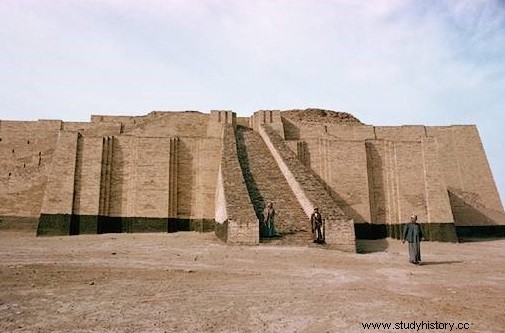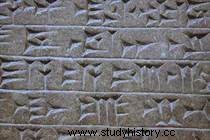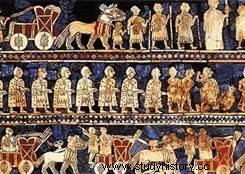 The first civilization in the history of mankind was born in Mesopotamia in the 5th millennium BC, in the fertile crescent that stretches between two rivers, the Tigris and the Euphrates. The Sumerians developed a brilliant civilization there and invented the first writing system:cuneiform writing. This discovery is revolutionary in the evolution of man; it marks the passage from prehistory to history. The Mesopotamian world had its mark on its neighbors in the Middle East, Egypt and the Indus Valley, before beginning its decline around 500 BC. By the advent of the Christian era, it had disappeared.
The first civilization in the history of mankind was born in Mesopotamia in the 5th millennium BC, in the fertile crescent that stretches between two rivers, the Tigris and the Euphrates. The Sumerians developed a brilliant civilization there and invented the first writing system:cuneiform writing. This discovery is revolutionary in the evolution of man; it marks the passage from prehistory to history. The Mesopotamian world had its mark on its neighbors in the Middle East, Egypt and the Indus Valley, before beginning its decline around 500 BC. By the advent of the Christian era, it had disappeared.
Map of the "River of Mesopotamia"
The term Mesopotamia, which means "land between rivers", refers to the floodplain that stretches between the Tigris and the Euphrates (current Iraq). When these streams overflowed with life, they submerged the land, depositing layers of fertile silt. But arid and uncultivable due to the lack of rainfall, this region had to wait for the invention of irrigation canals around 5500 BC for fields and crops to develop. Regularly watered, the latter provided an almost sufficient harvest each year. Some thousand years later, the invention of the wooden plow further increased agricultural output. The population grew accordingly and by 1300 BC hundreds of towns and villages dotted the region.
 Mesopotamia was sorely lacking in natural resources. For many activities, from construction to jewelry, raw materials such as wood, stones and minerals were imported from neighboring regions in exchange for surplus crops and handicrafts. The trade, in full expansion , was controlled by wealthy and powerful rulers, who developed collective projects such as irrigation networks and other flood defenses. These indeed represented a considerable danger for crops and homes. They were then thought to signify the anger of the gods, and the biblical episode of the deluge probably has its origins in the first Mesopotamian myths.
Mesopotamia was sorely lacking in natural resources. For many activities, from construction to jewelry, raw materials such as wood, stones and minerals were imported from neighboring regions in exchange for surplus crops and handicrafts. The trade, in full expansion , was controlled by wealthy and powerful rulers, who developed collective projects such as irrigation networks and other flood defenses. These indeed represented a considerable danger for crops and homes. They were then thought to signify the anger of the gods, and the biblical episode of the deluge probably has its origins in the first Mesopotamian myths.
Sumer and the first city-states in Mesopotamia
As of 3100 B.C. dozens of cities with up to 10,000 inhabitants occupied the land of Sumer in lower Mesopotamia. Independent states, they submitted to a king. These city-states were mostly populated by farmers, who worked outside the walls during the day to return to the city at night. Surplus crops were stored in temples and distributed to non-agricultural trades:blacksmiths, potters, masons, merchants, soldiers and priests. In the heart of the Sumerian cities, huge buildings soon arose attached to the temple, gigantic warehouses for the entire community.
The first Sumerian city-states were very different from our current cities. The money not being there, they had no market. The inhabitants received food, clothing and other products in payment for their labor, or resorted more simply to barter . While a few wealthy families had palaces and villas built, the majority of the population lived in modest accommodation, without running water or sanitary facilities. The constructions were of mud bricks dried in the sun; because of its rarity, the stone was reserved for carving.
The cradle of civilization and the invention of writing
Around 3400 BC, the Sumerians invented a form of primitive writing to record business transactions. Cuneiform writing, obtained by imprinting reeds on wet clay, took several hundred years to evolve into a more complex system. Its uses diversified, from the recording of legal codes and historical chronicles to the transmission of messages, including the writing of religious and literary texts. With many of the tablets surviving, historians have been able to paint a fairly comprehensive picture of life at that time, although the texts are difficult to interpret.
 During the period of the first dynasties (from 2900 to 2334 BC), conflicts opposed the city-states between they and most of them surrounded themselves with defensive walls. The art of war was refined:the sculptures of this period depict soldiers going to the battlefields aboard four-wheeled chariots drawn by donkeys. Around 2334 BC, Sargon , king of the city of Akkad, succeeded in conquering all the Mesopotamian city-states.
During the period of the first dynasties (from 2900 to 2334 BC), conflicts opposed the city-states between they and most of them surrounded themselves with defensive walls. The art of war was refined:the sculptures of this period depict soldiers going to the battlefields aboard four-wheeled chariots drawn by donkeys. Around 2334 BC, Sargon , king of the city of Akkad, succeeded in conquering all the Mesopotamian city-states.
His domain extended north to the Mediterranean coast. Uniting different peoples and cultures, he founded the first empire of humanity, which hardly survived its king, the rivalries between the city-states resuming with renewed vigor. One of them, Ur, at one time came to dominate the region, but the Sumerian decline was inexorable. It was Upper Mesopotamia which then dominated the region with the cities of Assur and then Babylon.
Hammurabi and its code
Babylon was at its height during the reign of Hammurabi (1792- 1750 BC). He is best known for the series of laws he had engraved on a high stone pillar. This stele, on which is one of the oldest legal texts in the world, reveals that women and children were considered the property of the husband, of the father. The penalties were severe:minor offenses were punishable by mutilation or death.
Combining diplomacy with military force, Hammurabi gradually expands his small kingdom (the city-state of Babylon) at the expense of his neighbors; he thus defeats the rulers of the city-states of Larsa, Elam, Mari, Eshnunna, and also submits the kingdom of Assyria. Around 1760 BC. AD, the Babylonian became ruler of a unified kingdom stretching from the Persian Gulf to the Tigris and Euphrates valleys (in the north) and the Mediterranean coast (in the west). P>
The Neo-Assyrian period in Mesopotamia
In 1595 BC, the Hittites, originating from the mountains of central Anatolia, where they were the first to use iron , invaded and sacked Babylon. Mesopotamia then entered a dark age that lasted 600 years. It was reborn around the year one thousand before our era with the impetus of the Assyrian cities of Assur and Nineveh. In the VII th century, the Assyrian Empire dominated the entire Middle East.
 Assyrian Society seems to have been organized in a very military fashion. Even the arts turn to war themes. Royal palaces were adorned with bas-reliefs depicting scenes of battles and defeated enemies being tortured, enslaved, or executed. However, by extending its influence to Egypt, conquered for the first time in the 7th century, Assyria had dangerously dispersed its resources and its armies. Revolts broke out, and on the death of King Ashurbanipal (669-627 BC), the empire fell into Babylonian hands.
Assyrian Society seems to have been organized in a very military fashion. Even the arts turn to war themes. Royal palaces were adorned with bas-reliefs depicting scenes of battles and defeated enemies being tortured, enslaved, or executed. However, by extending its influence to Egypt, conquered for the first time in the 7th century, Assyria had dangerously dispersed its resources and its armies. Revolts broke out, and on the death of King Ashurbanipal (669-627 BC), the empire fell into Babylonian hands.
The Neo-Babylonian period
Nebuchadnezzar II (604-562 BC) was the most famous and last king of Babylon. He put an end to the rebellions which tore his empire apart and was intractable towards his enemies. He did not hesitate in particular to deport the Jews to Babylon. Not shrinking from any expense to finance his wars and transform the city into an imperial capital (we owe him the famous hanging gardens) he left an empire divided and bloodless.
In 539 BC, Babylon offered weak resistance to the armies of the Persian king Cyrus the Great (559 -530 BC). From his kingdom on the Persian Gulf, Cyrus had conquered the Medes to the north and invaded Anatolia. He was at the head of an empire stretching from the Mediterranean then raised to Central Asia, the largest ever known. After centuries of excessive cultivation, the soil of Mesopotamia was exhausted. Its neighbors surpassed it in wealth and population, and under the foreign yoke, this civilization, one of the cradles of humanity , sunk into oblivion.
Bibliography on Mesopotamia
- From Véronique Grandpierre:History of Mesopotamia (Paperback). Editions Folio Histoire, February 2010.
- History Begins in Sumer, by Jean Bottero. Flammarion, 2017.
- Mesopotamia by Georges Roux. Story Points, 1995.
- Mesopotamia by Jean Bottero. Folio history, 1997.
